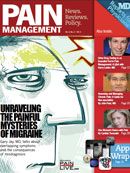A Gray Area of Treatment: Opioids, Chronic Pain, and the Elderly
Do primary care physicians who are not geriatricians under-treat chronic pain in older patients due to lack of education, concerns over adverse effects, and other barriers to the use of opioids?
Noting that “the use of opioid medications to treat chronic non-cancer pain… in older patients remains controversial,” due in part to some of the same concerns attending the use of opioid medications to treat chronic noncancer pain in the general adult population, the authors of “Primary Care Providers’ Perspective on Prescribing Opioids to Older Adults with Chronic Noncancer Pain: A Qualitative Study” (http://hcp.lv/qNBm5E) conducted focus groups with primary care providers to “elucidate primary care providers’ perceived barriers and facilitators to prescribing opioids as a treatment for chronic pain among older adults” and to “characterize providers’ experiences and attitudes towards using this class of medications in older patients.”
Previous work in this area has suggested that concerns regarding the potential for addiction and physical dependence; potential for abuse, misuse, and diversion; worries about possible adverse effects; and other concerns are the chief barriers to primary care physicians prescribing opioids for this patient population, whereas studies (http://hcp.lv/rabsOM) comparing the attitudes and concerns of geriatrics specialists with those of primary care physicians found that geriatricians “voiced far less concern for addiction and more concern for the possibility that patients’ pain was being undertreated.” If it is indeed the case that non-specialist physicians are undertreating pain in their elderly patients due to a combination of lack of education and misconceptions about the effects of opioids in this population, the authors surmised that “identifying primary care providers’ barriers to the use of opioids as a treatment for chronic pain among older adults could identify possible targets for intervention, and ultimately improve pain management in this expanding patient population.”
To this end, they convened a focus group of 26 primary care providers who practice in urban settings that serve older (mean age in the 80s), predominantly female, Latino and non-Hispanic white patients, many of whom “have significant functional and/or cognitive impairments” but live independently. Investigators asked participants to “share their experiences using opioids in older adults with chronic pain, characterize their use of these medications,” and describe perceived barriers and facilitators to prescribing opioids to their older patients. Providers were also asked to discuss legal/regulatory and abuse/misuse concerns, as well as their “comfort level” prescribing opioids for older patients with chronic pain.
The authors of the study reported that although every participant said they did not consider opioids to be first-line treatment for chronic pain in older patients, all but one of them prescribed opioids for pain in this population (though nearly all reported doing do “cautiously or hesitantly”). Fewer than half of participants viewed prescription opioids as effective therapy for all elderly patients with chronic pain (many were of the opinion that these medications only work when used in the “right” older patient). Patient and/or caregiver reliability was the most frequently cited patient-centered factor that affected prescribing decisions, along with having an identifiable etiology of pain. The presence of cognitive impairment, and concerns over polypharmacy and impaired drug metabolism were frequently cited as factors that decreased the likelihood a participant would prescribe opioids. Fear of harming the patients due to adverse events and side effects was the most frequently cited barrier to administering opioid therapy. Nearly onethird of participants also cited their lack of education in pain management and difficulty converting or dosing opioids as significant barriers. Patients’ reluctance to take opioids for pain was also a significant factor.
In their discussion of these results, the authors noted that “Managing older patients with chronic pain is frequently a complex and challenging task, which is often compounded by feelings of helplessness and an inability to optimally manage pain on the part of healthcare providers.” In their opinion, “mandates and guidelines put in place to improve pain management among older adults will likely continue to contribute to frustration” if the barriers that providers experience are not successfully addressed. A Gray Area of Treatment: Opioids, Chronic Pain, and the Elderly Do primary care physicians who are not geriatricians undertreat chronic pain in older patients due to lack of education, concerns over adverse effects, and other barriers to the use of opioids? Geriatric Pain Management Resources for Pain Management in Older Patients Pharmacological Management of Persistent Pain in Older Persons http://hcp.lv/o3Ry89 Opioids for Chronic Noncancer Pain in the Elderly http://hcp.lv/oIBYTm
Tell us what you think!
- What percentage of your patient panel is over the age of 65 years? How many of them are you currently treating for chronic pain?
- Do you use prescription opioids to treat chronic pain in this population? As first-line therapy?
- What factors do you consider when deciding whether to prescribe opioids in geriatric patients?
- In your experience, are elderly patients more likely to unintentionally misuse opioid medications than younger chronic pain patients? What factors do you look for when evaluating the potential for misuse and diversion with these patients?
E-mail tkunkler@mdmag.com to share your opinions and advice.
